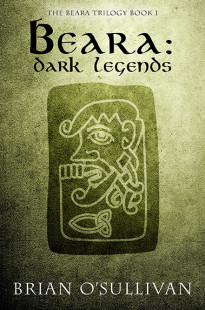
For many years, most Irish schoolkids had the dubious pleasure of studying the Tóraíocht Dhiarmada agus Gráinne (the Pursuit of Diarmuid and Gráinne) as part of the national Irish school curriculum. An epic Irish narrative, the oldest remaining copy is believed to date from the 15th century but it’s generally agreed to contain elements that date back to the 9th century. This proved little solace to most of us although we could, at least, console ourselves with the fact that it wasn’t Peig Sayers mind-numbing biography.
Remember this anyone?

Years later, I can now finally look at the Tóraíocht with less ‘negative’ eyes. The tale is actually quite unique in that it’s one of the first narratives (and one of the very few) in which mythological legend Fionn mac Cumhaill is portrayed as ‘The Bad Guy’ and shown to have human foibles. In this particular tale, he’s portrayed as an old man set to marry a much younger woman (Gráinne). Not enthralled at the prospect of being taken to bed by the elderly Fionn, Gráinne instead opts to put one of warriors at the wedding banquet that she fancies – Diarmuid – faoi geasa (under a magical obligation). While all the other guests are snoring under the influence of a sleeping draught, Diarmuid is forced to elope with her and the subsequent pursuit across Ireland by Fionn forms the basis of the narrative.
In Ireland, the Tóraíocht proved exceptionally popular (until it was made a compulsory school book!!) because it has all the elements of a good melodrama; a love triangle, young lovers, a pursuit, a revenge quest, action and adventure, etc. Given the story’s popularity and the scope of the legendary pursuit, local storytellers, back in the day, often stretched the chase to include topographical features in their own area to make the story more interesting for their audience. This is probably one of the key reasons for the many different existing variants.
Although some elements of the tale are difficult for a contemporary audience (and incomprehensible to a modern schoolkid), there are some motifs that stand out more than others. One of these is the sexual restraint displayed by the hero. While being chased by Fionn and his men, Diarmuid marks his loyalty to his leader and the abstention from sexual activity, by leaving an uncooked fish behind. This way, when Fionn subsequently locates their campsite, he knows that there hasn’t been any hanky-panky.
In fact, a prolonged period of time (and many adventures) passes before Diarmuid actually succumbs to temptation. This occurs when Gráinne is crossing a small stream and a spray of water spurts up to splash on the inside of her thigh. Looking at Diarmuid, Gráinne remarks – cuttingly – that the water is actually bolder than he is. Spurred by her words, Diarmuid takes her and “makes a woman of her”. Needless to say, absolutely no clarification of this particular scene took place during my school reading at least.
Another interesting motif of the tale is the constant need for the lovers to sleep in a different location every night (due the constant harrying by Fionn and his hunting dogs, always on their trail, always just behind). Over the subsequent centuries, this particular motif was absorbed into local folklore through the dolmans – neolithic burial portals that consist of a large flat rock overlaying two support rocks. Again, local storytellers started to explain the presence of these startling monuments by describing them as the ‘leaba’ (beds) of the fleeing lovers.
Beware! Ancient Mythological Sex Site!
Examples of these ‘leaba’ exist all over the country and many still retain names associated with the Tóraíocht (e.g. Labby Rock in county Sligo). One of the more interesting folk beliefs that also developed from this interpretation, was that young women had a much better chance of becoming pregnant if they slept on the leaba (linking this action to that of Gráinne who became pregnant over the course of the chase).
Looking back on my own schooldays, I can actually understand why those in charge wanted to include the Tóraíocht in the national educational curriculum. It’s a very important piece of our culture that everyone should be familiar with and … (yaaaawn!) etc. etc. To be honest, the effort to inspire kids with this mythological tale was doomed to failure. Kids in my class never received any explanation as to what the story really entailed, had no comprehension (or therefore, appreciation) of the many references it contained. Many of the actions and events were obscure to the point of ‘alien’ and therefore had no real relevance or meaning to us. It’s hardly surprising most of us yawned our way through it and hoped against hope the bloody bell would ring soon.

Fortunately, nowadays, there are other – more accessible – versions of the tale available. One of my favourites is Colmán Ó Raghallaigh’s graphic novel (entitled: An Tóraíocht) but there are several others including the recent movie ‘Pursuit’ by Paul Mericer (which, admittedly, I haven’t seen). Hopefully, these more contemporary versions (or equivalents) are used nowadays. Even the sex scenes wouldn’t have saved what we were being taught all those years ago.



